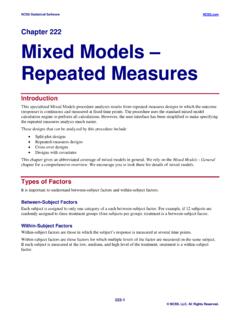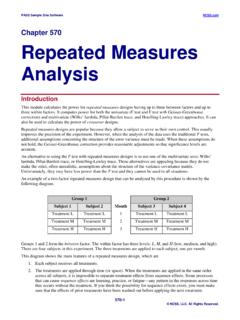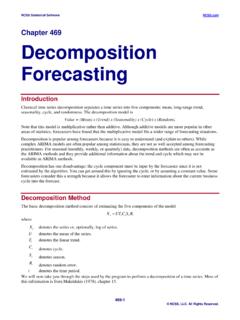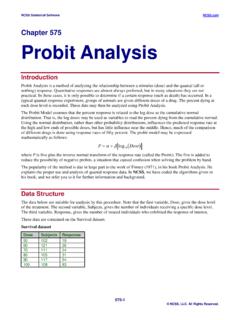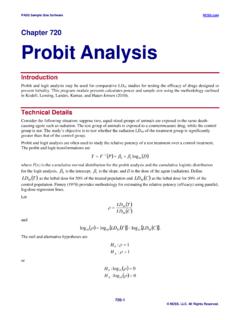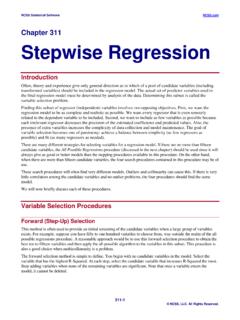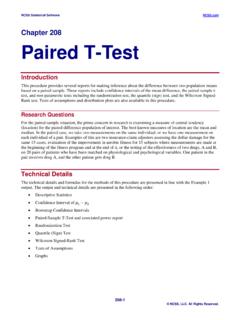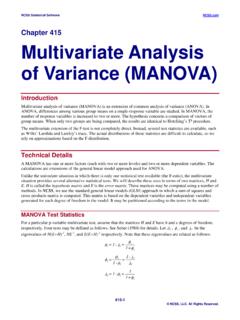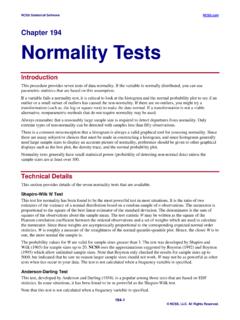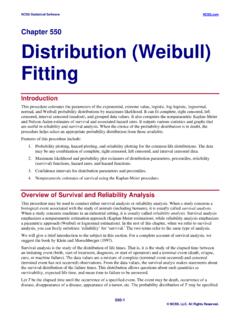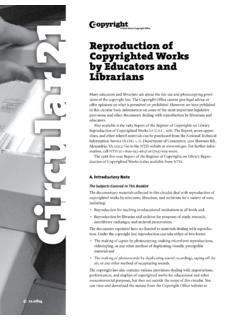Transcription of Circular Data Analysis - NCSS
1 NCSS Statistical Software 230-1 NCSS, LLC. All Rights Reserved. Chapter 230 Circular Data Analysis Introduction This procedure computes summary statistics, generates rose plots and Circular histograms, computes hypothesis tests appropriate for one, two, and several groups, and computes the Circular correlation coefficient for Circular data. Angular data, recorded in degrees or radians, is generated in a wide variety of scientific research areas. Examples of angular (and cyclical) data include daily wind directions, ocean current directions, departure directions of animals, direction of bone-fracture plane, and orientation of bees in a beehive after stimuli.
2 The usual summary statistics, such as the sample mean and standard deviation, cannot be used with angular values. For example, consider the average of the angular values 1 and 359. The simple average is 180. But with a little thought, we might conclude that 0 is a better answer. Because of this and other problems, a special set of techniques have been developed for analyzing angular data. This procedure implements many of those techniques. NCSS Statistical Software Circular Data Analysis 230-2 NCSS, LLC. All Rights Reserved. Technical Details Suppose a sample of n angles aaan12,,..,is to be summarized. It is assumed that these angles are in degrees.
3 Fisher (1993) and Mardia & Jupp (2000) contain definitions of various summary statistics that are used for angular data. These results will be presented next. Let ( )C = papiincos= 1, C = Cnpp, ( )S = papiinsin= 1, S = Snpp, R = CSppp22+, R = Rnpp T = SCCSSCCSCSC pppppppppppptan,tantan, >> +< +<> 111000200 To interpret these quantities it may be useful to imagine that each angle represents a vector of length one in the direction of the angle. Suppose these individual vectors are arranged so that the beginning of the first vector is at the origin, the beginning of the second vector is at the end of the first, the beginning of the third vector is at the end of the second, and so on.
4 We can then imagine a single vector a that will stretch from the origin to the end of the last observation. R1, called the resultant length, is the length of a. R1 is the mean resultant length of a. Note thatR1 varies between zero and one and that a value of R1 near one implies that there was little variation in values of the angles. The mean direction, , is a measure of the mean of the individual angles. is estimated byT1. The Circular variance, V, measures the variation in the angles about the mean direction. V varies from zero to one. The formula for V is V = R11 The Circular standard deviation, v, is defined as ()v = R 21ln The Circular dispersion, used in the calculation of confidence intervals, is defined as =TR12212 The skewness is defined as ()()s = RTTR22113221sin/ NCSS Statistical Software Circular Data Analysis 230-3 NCSS, LLC.
5 All Rights Reserved. The kurtosis is defined as ()()k = RTTRR221141221cos Correction for Grouped Data When the angles are grouped, a multiplicative correction for R may be necessary. The corrected value is given by R = gRpp* where ()g = JJ /sin/ Here J is the number of equi-sized arcs. Thus, for monthly data, J would be 12. Confidence Interval for the Mean Direction Upton & Fingleton (1989) page 220 give a confidence interval for the mean direction when no distributional assumption is made as ()T z112 sin / where () = nHR142 ( )( )( )( )H = nTaTaiiinin122221111coscossinsin+ == Circular Uniform Distribution Uniformity refers to the situation in which all values around the circle are equally likely.
6 The probability distribution on a circle with this property is the Circular uniform distribution, or simply, the uniform distribution. The probability density function is given by ( ) fa=1360 The probability between any two points is given by () aaaaaaaaPr|,121221212360< += NCSS Statistical Software Circular Data Analysis 230-4 NCSS, LLC. All Rights Reserved. Tests of Uniformity Uniformity refers to the situation in which all values around the circle are equally likely. Occasionally, it is useful to perform a statistical test of whether a set of data do not follow the uniform distribution. Several tests of uniformity have been developed.
7 Note that when any of the following tests are rejected, we can conclude that the data were not uniform. However, when the test is not rejected, we cannot conclude that the data follow the uniform distribution. Rather, we do not have enough evidence to reject the null hypothesis of uniformity. Rayleigh Test The Rayleigh test, discussed in Mardia & Jupp (2000) pages 94-95, is the score test and the likelihood ratio test for uniformity within the von Mises distribution family. The Rayleigh test statistic is22nR. For large samples, the distribution of this statistic under uniformity is a chi-square with two degrees of freedom with an error of approximation of( )On 1.
8 A closer approximation to the chi-square with two degrees of freedom is achieved by the modified Rayleigh test. This test, which has an error of ( )On 2, is calculated as follows. SnnRnR*= +1122224 Modified Kuiper's Test The modified Kuiper's test, Mardia & Jupp (2000) pages 99-103, was designed to test uniformity against any alternative. It measures the distance between the cumulative uniform distribution function and the empirical distribution function. It is accurate for samples as small as 8. The test statistic, V, is calculated as follows VVnnn=++ 01550 where Vainainnnitoniitoni= +==maxmin( )( )113603601 Published critical values of V are V Alpha This table was used to create an interpolation formula from which the alpha values are calculated.
9 Watson Test The following uniformity test is outlined in Mardia & Jupp pages 103-105. The test is conducted by calculating U2 and comparing it to a table of values. If the calculated value is greater than the critical value, the null hypothesis of uniformity is rejected. Note that the test is only valid for samples of at least eight angles. The calculation of U2is as follows Uuinuniin2122112112= + += ( ) NCSS Statistical Software Circular Data Analysis 230-5 NCSS, LLC. All Rights Reserved. where uuniin== ( )1, uaii( )( )=360 aaaan(1)()( )() 23 are the sorted angles. Note that maximum likelihood estimates of and are used in the distribution function.
10 Mardia & Jupp (2000) present a table of critical values that has been entered into NCSS. When a value of U2 is calculated, the table is interpolated to determine its significance level. Published critical values of U2 are U2 Alpha Von Mises Distributions The Von Mises distribution takes the role in Circular statistics that is held by the normal distribution in standard linear statistics. In fact, it is shaped like the normal distribution, except that its tails are truncated. The probability density function is given by ()( )()[] faIa; ,expcos = 120 where( ) Ixp (the modified Bessel function of the first kind and order p) is defined by ( )() Ixrprxpprrp=+ == + 120 1202!
